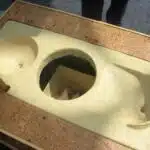Maintaining a clean and hygienic bathroom is essential for the overall health and well-being of your household. While it may seem like a mundane task, cleaning your toilet brush and holder is just as important as scrubbing your toilet bowl. Not only do these tools come into direct contact with harmful bacteria and germs, but they can also contribute to unpleasant odors if not properly cleaned.
As a housekeeping expert, I am here to guide you through the process of effectively cleaning your toilet brush and holder. By following these simple steps, you can ensure that your bathroom stays fresh, clean, and germ-free. With just a few minutes of your time, you can take an important step towards creating a healthy and welcoming environment for yourself and those around you.
Gathering Your Supplies
To ensure an effective and efficient cleaning process for your toilet brush and holder, it is essential to gather all the necessary supplies beforehand. Organizing supplies in advance saves you time and ensures that you have everything you need at hand. Here are some of the items that you will require:
Firstly, a pair of gloves will protect your hands from coming into contact with any bacteria or germs present on the brush and holder. Next, a scrub brush or toothbrush can be used to remove any stubborn stains or dirt that may have accumulated over time. A bucket filled with warm water and soap is also essential for soaking the brush and holder before washing.
Time-saving tips can help make this process quicker without compromising on effectiveness. Start by filling the bucket with warm water and soap before removing the brush from its holder. This allows it to soak while you clean other areas of your bathroom. Additionally, if there are multiple brushes in your home, consider cleaning them all at once to save time.
Choosing the right cleaner is crucial for ensuring that your toilet brush and holder are free from germs and bacteria. In the next section, we will discuss different types of cleaners available in the market and what works best for this particular cleaning task.
Choosing The Right Cleaner
When it comes to cleaning your toilet brush and holder, choosing the right cleaner is essential. There are two main types of cleaners: organic and chemical. Organic cleaners use natural ingredients such as vinegar or baking soda, while chemical cleaners contain harsh chemicals that can be harmful if not used properly. It’s important to consider which type of cleaner is best for you based on your personal preferences and needs.
Another factor to consider when choosing a cleaner is whether or not you want a fragrance or fragrance-free option. Fragrance-free cleaners are ideal for those with allergies or sensitivities to scents, while fragranced cleaners can leave a pleasant scent in your bathroom. Ultimately, the decision between fragrance vs fragrance-free will come down to personal preference.
When selecting a cleaner for your toilet brush and holder, keep in mind that both organic and chemical options can be effective if used correctly. Consider factors such as cost, availability, and environmental impact when making your decision. By taking the time to choose the right cleaner for your needs, you’ll ensure a clean and fresh bathroom every time.
Now that you’ve chosen the right cleaner for your toilet brush and holder, it’s time to move on to removing excess water from the brush before storing it away.
Removing Excess Water
After choosing the right cleaner for your toilet brush and holder, it’s time to think about removing bacteria. Toilet brushes can harbor harmful bacteria that can spread quickly if not properly cleaned. To prevent this from happening, it’s important to clean your brush and holder regularly.
One effective way to remove bacteria is by using white vinegar. Simply mix equal parts of white vinegar and water in a bucket or sink, then submerge your toilet brush and holder for at least 30 minutes. After soaking, rinse thoroughly with hot water and allow them to air dry completely before using again.
Once you’ve removed any bacteria, it’s important to make sure your brush and holder are completely dry before storing them away. A damp environment can promote the growth of mold and mildew. One drying technique is to hang your brush upside down over the toilet bowl until it’s completely dry. And for the holder, simply turn it upside down on a towel or dish rack until all excess water has drained out. By following these simple steps, you’ll be able to keep your toilet brush and holder clean and free from harmful bacteria.
To take things one step further in ensuring a hygienic bathroom environment, disinfecting your brush should also be considered as part of your cleaning routine. In the next section, we’ll discuss the proper ways to disinfect your toilet brush without causing damage or compromising its effectiveness.
Disinfecting Your Brush
To keep your toilet brush clean and hygienic, disinfect it regularly to kill any bacteria that may be present. One effective way to do this is by using bleach. Mix one part bleach with nine parts water in a large bucket, then submerge the brush in the solution for at least 10 minutes.
After soaking, rinse the brush thoroughly with hot water and let it air dry before returning it to its holder. Remember to wear gloves when handling bleach and ensure proper ventilation in the room.
To save time, consider disinfecting your toilet brush while you clean your bathroom. Start by spraying down surfaces with a cleaning solution, then use a rag or sponge to wipe them clean. Once you’re finished, place the brush in the bleach solution for 10 minutes while you tackle other cleaning tasks.
Next up: Sanitizing Your Holder.
Sanitizing Your Holder
Disinfecting your toilet brush is only half the battle. If you neglect to sanitize the holder, you’re essentially putting a newly disinfected brush back into a dirty environment. It’s important to clean both the brush and its holder on a regular basis.
Using bleach is an effective way to sanitize your toilet brush holder. Start by emptying any remaining water from the holder, then add a mixture of one part bleach to ten parts water. Allow the solution to sit for at least 10 minutes before rinsing thoroughly with hot water. Be sure to wear gloves and work in a well-ventilated area when using bleach.
If your holder is beyond cleaning or has seen better days, it may be time to replace it altogether. Look for a new holder that has drainage holes or slots to prevent water from pooling at the bottom, which can lead to mold growth. Remember, investing in a new holder every so often can help maintain good hygiene in your bathroom.
When it comes to scrubbing the brush bristles themselves, there are certain precautions you should take. Stay tuned for our next section on how to properly clean and maintain your toilet brush for optimal use and hygiene.
Scrubbing The Brush Bristles
Effective techniques for scrubbing toilet brush bristles include using a cleaning solution and hot water. Firstly, remove any excess debris from the brush by shaking it over the toilet bowl. Next, apply a cleaning solution to the bristles and use a scrubbing motion to remove any stains or buildup. It is important to focus on each individual bristle to ensure it is thoroughly cleaned.
Common mistakes to avoid while scrubbing toilet brush bristles include using harsh chemicals that can damage the bristles and not allowing enough time for cleaning. Harsh chemicals can cause the bristles to become brittle and break off, rendering them ineffective in cleaning. Furthermore, rushing through the cleaning process may result in missed spots or inadequate cleaning.
To ensure your toilet brush stays clean and effective, it is recommended to replace it every six months. Additionally, always store your toilet brush in its holder with the bristles facing upward to allow for proper drying and prevent bacteria growth.
- Shake excess debris from the brush before applying cleaner
- Scrub each individual bristle thoroughly
- Store brush in holder with bristles facing upward for proper drying
Transition into subsequent section: To complete the cleaning process, it’s important to rinse both the brush and holder thoroughly.
Rinsing The Brush And Holder
Once you have scrubbed the toilet bowl with a brush, it is important to rinse the brush and holder thoroughly. This step is crucial in ensuring that your toilet remains clean and hygienic. Effective cleaning techniques should be followed to ensure that all bacteria and germs are eliminated.
To begin, hold the brush under running water and use your hand to remove any remaining debris or particles. You may also choose to use a disinfectant spray on both the brush and holder before rinsing them off. Ensure that all surfaces are thoroughly cleaned before moving onto the next step.
Safety precautions should also be taken into consideration when cleaning your toilet brush and holder. Always wear gloves to protect your hands from any harmful chemicals or bacteria. Additionally, make sure that you dispose of any used cleaning materials properly to avoid contamination or illness.
The next step after rinsing your toilet brush and holder is drying them completely before storing them away. This ensures that no moisture is left behind, which can lead to bacterial growth. In the next section, we will discuss how to effectively dry your tools for optimal cleanliness and hygiene in your bathroom.
Drying Your Tools
- Drying the holder is an important step in keeping a toilet brush and holder clean.
- To dry the holder, it is essential to use a clean cloth and to ensure that it is completely wiped dry.
- To dry the brush, it is advisable to shake off any excess water and to allow it to air dry before placing it back in the holder.
- In addition, it is important to ensure that the holder is placed in a well-ventilated area to minimize the risk of bacteria and mold buildup.
Drying The Holder
To maintain the cleanliness of your toilet brush and holder, it is important to dry them properly. After cleaning the brush and holder, you can start air drying them. Place the brush on top of the holder and leave it to dry in a well-ventilated area. This will allow any excess water to evaporate and prevent mold or mildew from forming.
If you prefer towel drying your tools, make sure to use a clean and dry cloth. Wipe the brush and holder thoroughly until all moisture has been absorbed. It is important to make sure that both tools are completely dry before storing them away. Any remaining moisture can lead to bacterial growth, which can cause unpleasant odors and even illness.
When drying the holder, pay particular attention to any crevices or corners where water may collect. Use a cotton swab or toothbrush to reach these areas and ensure they are completely dry. Remember that proper drying techniques will not only prolong the life of your toilet brush and holder but also prevent harmful bacteria from proliferating in your bathroom.
Drying The Brush
Now that we have discussed the importance of properly drying your toilet brush and holder, let us now focus on specific techniques for drying the brush itself. After using the brush to clean your toilet bowl, it is important to thoroughly dry it before storing it away. This will prevent any bacteria from forming and keep your bathroom clean and hygienic.
One effective method for drying your toilet brush is air drying. Simply place the brush on top of the holder and leave it in a well-ventilated area until all excess water has evaporated. This will not only ensure that the brush is completely dry but also prevent any mold or mildew from forming. However, if you prefer towel drying your tools, make sure to use a clean and dry cloth to wipe the brush until all moisture has been absorbed.
When drying your toilet brush, pay special attention to its bristles. Ensure that they are completely dry before storing them away. If you notice that there is still some moisture on the bristles after air or towel drying, use a hair dryer set on low heat to gently blow warm air onto them until they are fully dried. Remember that proper drying techniques not only prolong the life of your toilet brush but also maintain its effectiveness in cleaning your toilet bowl.
Storing Your Brush And Holder
As you finish cleaning your toilet brush and holder, the next step is to store them properly. Maximizing space in your bathroom is essential, so it is best to choose a holder that will not take up too much room. There are various decorative holder options available that can complement your bathroom’s style, while also being functional.
When choosing a holder, consider one with ventilation holes or an open design to allow air flow and prevent moisture buildup. This will help keep your brush dry and reduce the risk of mold or bacteria growth. Additionally, opt for a holder with a removable drip tray that can be easily cleaned or replaced when necessary.
Properly storing your toilet brush and holder not only keeps them organized but also helps maintain their cleanliness. In the next section, we will discuss how to clean hard-to-reach areas around the toilet bowl and base to ensure a thorough clean every time.
Cleaning Hard-To-Reach Areas
When it comes to cleaning hard-to-reach areas, effective tools are essential. These areas can include spaces such as behind the toilet, under the sink, and in tight corners. To make your cleaning process more efficient, invest in tools that are designed for these areas. For example, a long-handled scrub brush can be used to clean the back of the toilet bowl or around tight corners.
In addition to using effective tools, safety precautions should also be taken when cleaning hard-to-reach areas. For instance, if you need to use a ladder to reach high spaces, ensure that it is stable and secure before climbing up. Always wear gloves when handling cleaning solutions and avoid standing on unstable surfaces such as chairs or stools.
Cleaning hard-to-reach areas may seem like a daunting task, but with the right tools and safety precautions in place, it can be done efficiently and safely. By investing in effective tools such as long-handled scrub brushes and taking necessary safety precautions such as wearing gloves and ensuring stability when using ladders or standing on surfaces, you can keep your home clean without putting yourself at risk.
Transition: Now that we have covered how to effectively clean hard-to-reach areas while staying safe, let’s take a look at dealing with stubborn stains that may require extra attention.
Dealing With Stubborn Stains
- Rust stains on a toilet brush and holder can be removed by soaking the object in white vinegar for several hours and then scrubbing it with baking soda and a brush.
- Mold can be removed by using a mixture of equal parts bleach and water and scrubbing with a stiff brush.
- Grime can be removed from the toilet brush and holder by dipping the brush in a bowl of hot water and a few drops of dish soap and scrubbing with a sponge.
- To completely remove rust, it is best to use a rust removal product such as WD-40 or a rust-removal product specifically designed for metal surfaces.
- Bleach can be used to remove mold, but it should be used sparingly and with care in order to avoid damaging the material around it.
- A mixture of baking soda and dish soap can help to scrub away grime from the toilet brush and holder, but it is important to use a non-abrasive sponge to prevent damaging the object.
Removing Rust
Removing rust from a toilet brush and holder can be a daunting task, but with the right techniques, it is possible to achieve excellent results. Rust stains can occur when the metal components of the holder come into contact with moisture. To remove rust, one can use vinegar, which is an effective and affordable cleaning agent.
To start, fill a container with vinegar and soak the toilet brush and holder in it for several hours or overnight. The acidity in vinegar helps to break down rust while preventing its formation. After soaking, use a stiff brush to scrub away any remaining rust stains. Rinse thoroughly with water and dry completely before using again.
To prevent future rust formation on your toilet brush and holder, consider storing them in a dry area or using plastic alternatives that are not susceptible to rusting. Regular cleaning also helps to prevent build-up that can lead to rust formation. By following these simple tips, you can maintain a clean and hygienic toilet brush and holder that will last for years to come.
Cleaning Mold
Moving on to another stubborn stain that homeowners often encounter in their bathrooms, we have mold. Removing stubborn mold stains can be a challenging task, but it is essential to do so for the health and safety of those using the space. Mold stains can occur due to moisture build-up in damp areas, such as showers and sinks. To effectively remove mold stains, one needs to use the right techniques and cleaning agents.
To start, mix equal parts water and white vinegar in a spray bottle. Apply the solution onto the affected area generously and let it sit for 30 minutes. Scrub away any remaining mold stains with a soft-bristled brush or sponge. Rinse thoroughly with water and dry completely before using again. This method works well for removing mildew buildup on tiles and grout as well.
Preventing future mold growth is crucial in maintaining a clean bathroom environment. Ensure proper ventilation by keeping windows open or using exhaust fans when taking a shower or bath. Regularly cleaning surfaces with an antimicrobial cleaner can also help prevent mold growth. Additionally, fix any leaks or plumbing issues immediately to prevent excess moisture from building up.
In conclusion, removing stubborn mold stains requires patience and diligence, but it is essential for maintaining a hygienic bathroom environment. By following the proper cleaning techniques and preventative measures, homeowners can keep their bathrooms free from unwanted mold growth and ensure the safety of themselves and their loved ones.
Scrubbing Grime
Moving on to another stubborn stain that homeowners often encounter in their homes, we have grime. It is an unsightly and challenging stain to remove, but with effective techniques and eco-friendly options, it is possible to achieve a clean and hygienic home environment. Grime can accumulate on various surfaces such as countertops, floors, walls, and appliances due to regular use and exposure to dirt and oil.
To effectively scrub away grime stains, start by gathering your cleaning supplies. You will need a bucket of warm water, mild detergent or all-purpose cleaner, a scrub brush or sponge, and a microfiber cloth for wiping down surfaces. Dip the brush or sponge into the soapy water solution and start scrubbing the affected area gently. For more stubborn stains, apply some baking soda onto the surface before scrubbing. Rinse with clean water afterward and dry with a microfiber cloth.
Eco-friendly options for removing grime stains include using vinegar or lemon juice instead of harsh chemicals. Mix equal parts water and vinegar or lemon juice in a spray bottle and apply onto the affected area generously. Let it sit for a few minutes before scrubbing with a brush or sponge. Rinse thoroughly with water afterward to prevent any residue buildup. These natural cleaning agents are not only effective but also safe for you and the environment.
In conclusion, dealing with stubborn stains requires patience, effort, and knowledge of effective cleaning techniques. Grime stains can be removed using simple household items such as soap, vinegar, baking soda, or lemon juice. By incorporating eco-friendly options into your cleaning routine regularly, you can maintain a clean home environment without compromising your health or the planet’s well-being.
Tackling Lingering Odors
Similar to dealing with stubborn stains, lingering odors in your toilet brush and holder can be a nuisance. As such, it is important to not only clean them properly but also maintain regular cleaning to prevent the buildup of bacteria and germs. Cleaning your toilet brush and holder is a simple process that requires few materials and steps.
Firstly, gather all necessary cleaning supplies including gloves, disinfectant cleaner, and a scrub brush. You can also use vinegar as an alternative cleaning product which is less harsh on the environment. It is important to always wear gloves when handling dirty toilet brushes as they may contain bacteria that can cause illness.
Secondly, remove the brush from its holder and dispose of any excess water or debris into the toilet bowl. Next, apply disinfectant cleaner or vinegar directly onto the bristles of the brush and scrub thoroughly until all dirt and grime are removed. Rinse the brush under running water then place it back into its holder.
Lastly, clean the holder by pouring disinfectant cleaner or vinegar into it and let it sit for 5-10 minutes before rinsing it out with hot water. Wipe down the exterior of the holder with a clean cloth or paper towel then allow it to air dry. By following these tips and using appropriate products you can ensure that your toilet brush and holder remain clean and sanitary.
To maintain regular cleaning schedule of your toilet brush and holder, make sure to rinse them after every use to prevent the buildup of bacteria. Additionally, consider replacing your toilet brush every six months or as needed if it becomes damaged or heavily soiled. By taking these simple steps you can ensure that your bathroom remains hygienic for you and your guests.
Maintaining Regular Cleaning Schedule
To maintain a clean and hygienic home, it is essential to establish a regular cleaning schedule. This helps to ensure that every area of the house is cleaned thoroughly and frequently. In particular, high traffic areas such as bathrooms and kitchens need frequent cleaning to prevent the buildup of germs and bacteria. It is important to allocate time for cleaning on a regular basis so that it becomes a habit rather than a chore.
Cleaning frequency depends on various factors such as the number of people in the household, lifestyle habits, and personal preferences. However, it is recommended to clean high traffic areas such as toilets at least once per week. To make efficient use of time, it can be helpful to create a cleaning checklist or schedule which outlines specific tasks that need to be completed each day or week. By doing this, you can break down larger tasks into smaller ones and manage your time more effectively.
Effective time management is key when it comes to maintaining a consistent cleaning routine. Rather than waiting for messes to pile up before taking action, it’s best to tackle them immediately before they become harder to clean up. By regularly decluttering surfaces and wiping down counters after use, you can reduce the amount of deep cleaning required later on. Remember that small efforts made consistently over time will lead to big results in terms of cleanliness and hygiene throughout your home.
| Advantages | Disadvantages | Tips for Success |
|---|---|---|
| Improved physical health due to reduced exposure to germs | Time-consuming | Prioritize cleaning tasks based on importance |
| Reduced stress levels due to increased organization | Requires discipline | Involve family members in the process |
| Enhanced mental wellbeing due to improved aesthetics | Can be tiring | Set achievable goals for each session |
| Increased productivity due to cleaner working spaces | May require purchasing additional equipment | Don’t get discouraged if you miss a day or two |
As we have seen, maintaining a regular cleaning schedule is essential for creating a clean and hygienic living environment. Cleaning frequency depends on various factors, but it is recommended to clean high traffic areas at least once per week. Effective time management is crucial when it comes to maintaining consistency in your cleaning routine. By using the tips provided above and referring to the table, you can ensure that your cleaning efforts are efficient and successful. In the next section, we will explore alternative cleaning methods that can be used in addition to traditional cleaning techniques.
Alternative Cleaning Methods
Maintaining a regular cleaning schedule for your bathroom is important, but cleaning the toilet brush and holder can often be neglected. Did you know that according to a study conducted by the National Sanitation Foundation, the average toilet brush contains more bacteria than a toilet seat? This is why it’s crucial to clean your toilet brush and holder regularly.
Eco-friendly solutions are becoming increasingly popular among housekeeping experts. Instead of using harsh chemicals, try using natural alternatives such as vinegar or baking soda. To clean your toilet brush holder, mix equal parts water and vinegar and let it sit for about 15 minutes. Then rinse it thoroughly with warm water and allow it to air dry.
DIY cleaning hacks can also come in handy when trying to maintain a clean toilet brush and holder. One easy hack is to pour some bleach into the bottom of the holder before placing the brush back in. This will help disinfect both the brush and holder. Another hack is to use hydrogen peroxide spray on both items after each use.
Preventing bacteria buildup on your toilet brush and holder is essential for maintaining a hygienic bathroom environment. In our next section, we will discuss some tips for preventing bacterial growth on these items. By implementing these tips along with regular cleaning schedules and eco-friendly solutions, you can ensure that your bathroom remains safe and healthy for everyone who uses it.
Tips For Preventing Bacteria Buildup
Preventing cross contamination is a crucial aspect of maintaining a clean and hygienic toilet brush and holder. One way to achieve this is by using separate brushes for different toilets within your home. This prevents the spread of bacteria from one toilet to another, minimizing the risk of infections and illnesses.
Chemical free cleaning methods are also highly recommended for toilet brush maintenance. Chemicals can be harsh on the bristles of the brush, causing them to wear out faster than usual. Furthermore, some chemicals may not be effective against certain types of bacteria and viruses, leading to incomplete cleaning. Instead, consider using natural products like vinegar or baking soda mixed with water to clean your toilet brush and holder.
Another useful tip is to allow your toilet brush and holder to dry completely between uses. Moisture creates an ideal environment for bacteria growth, leading to unpleasant odors and potential health risks. After use, rinse the brush thoroughly under running water, shake off any excess water, and leave it in a well-ventilated area until it dries completely before replacing it in its holder.
By following these tips for preventing cross contamination and using chemical free cleaning methods while allowing adequate drying time between uses, you can maintain a clean and hygienic toilet brush and holder. Remember that hygiene is essential for overall health and well-being – take care when cleaning your bathroom tools!
Conclusion
Maintaining a clean and hygienic bathroom is crucial for overall health and well-being. One often overlooked item in the bathroom is the toilet brush and holder. Cleaning these items regularly can prevent bacteria buildup and unpleasant odors. To properly clean your toilet brush and holder, start by gathering your supplies. Choose a suitable cleaner that will effectively disinfect the brush and holder. After cleaning, ensure that all excess water is removed to prevent mold growth.
Disinfecting the brush should be a top priority as it comes into direct contact with germs and bacteria. Sanitizing the holder is also important to prevent cross-contamination between different areas of your bathroom. If you notice lingering odors, try using baking soda or vinegar to freshen up the area.
An interesting statistic to consider is that according to a study by NSF International, the toilet brush holder was found to be one of the most germ-infested items in the home, with more than 64% of holders testing positive for coliform bacteria. This alarming fact highlights the importance of regularly cleaning and disinfecting your toilet brush and holder.
As a housekeeping expert, it’s essential to emphasize that maintaining good hygiene practices in your bathroom can significantly impact your overall health. Regularly cleaning your toilet brush and holder ensures that harmful bacteria are eliminated, preventing illness and promoting cleanliness. By following these simple steps, you can keep your bathroom sparkling clean and free from harmful germs.
Image Credits
- “Hillary Clinton Toilet Brush” by JeepersMedia (featured)





























